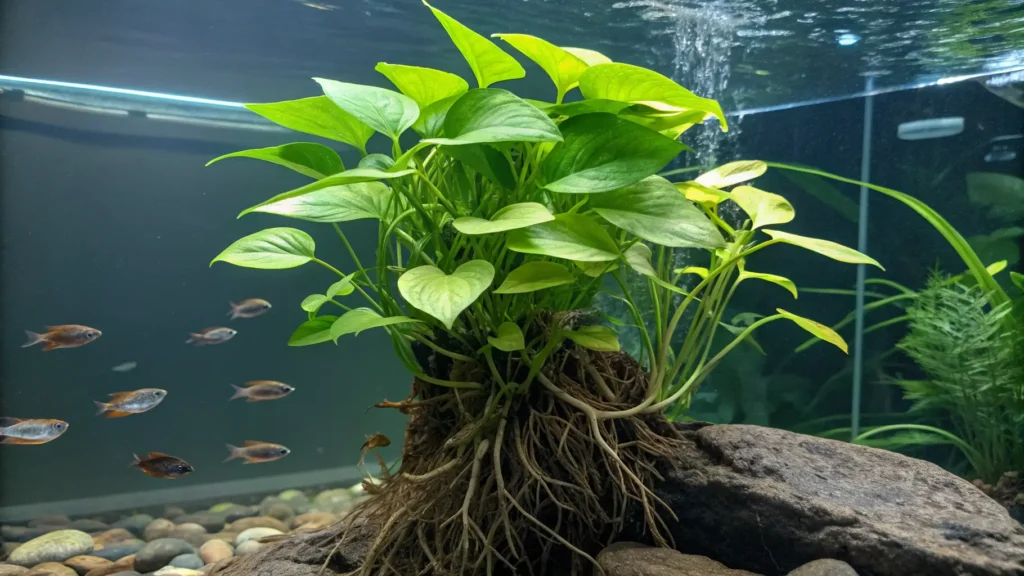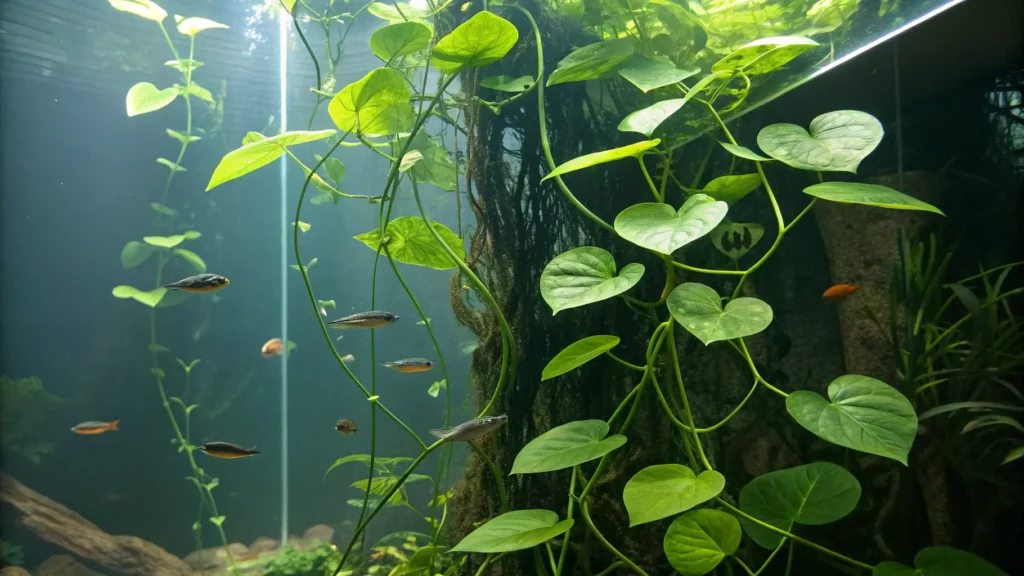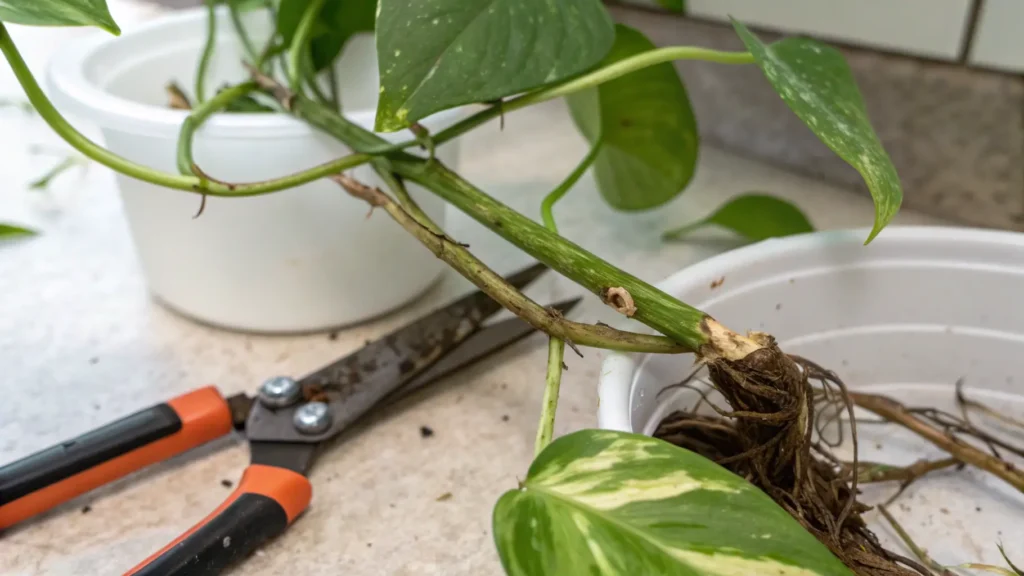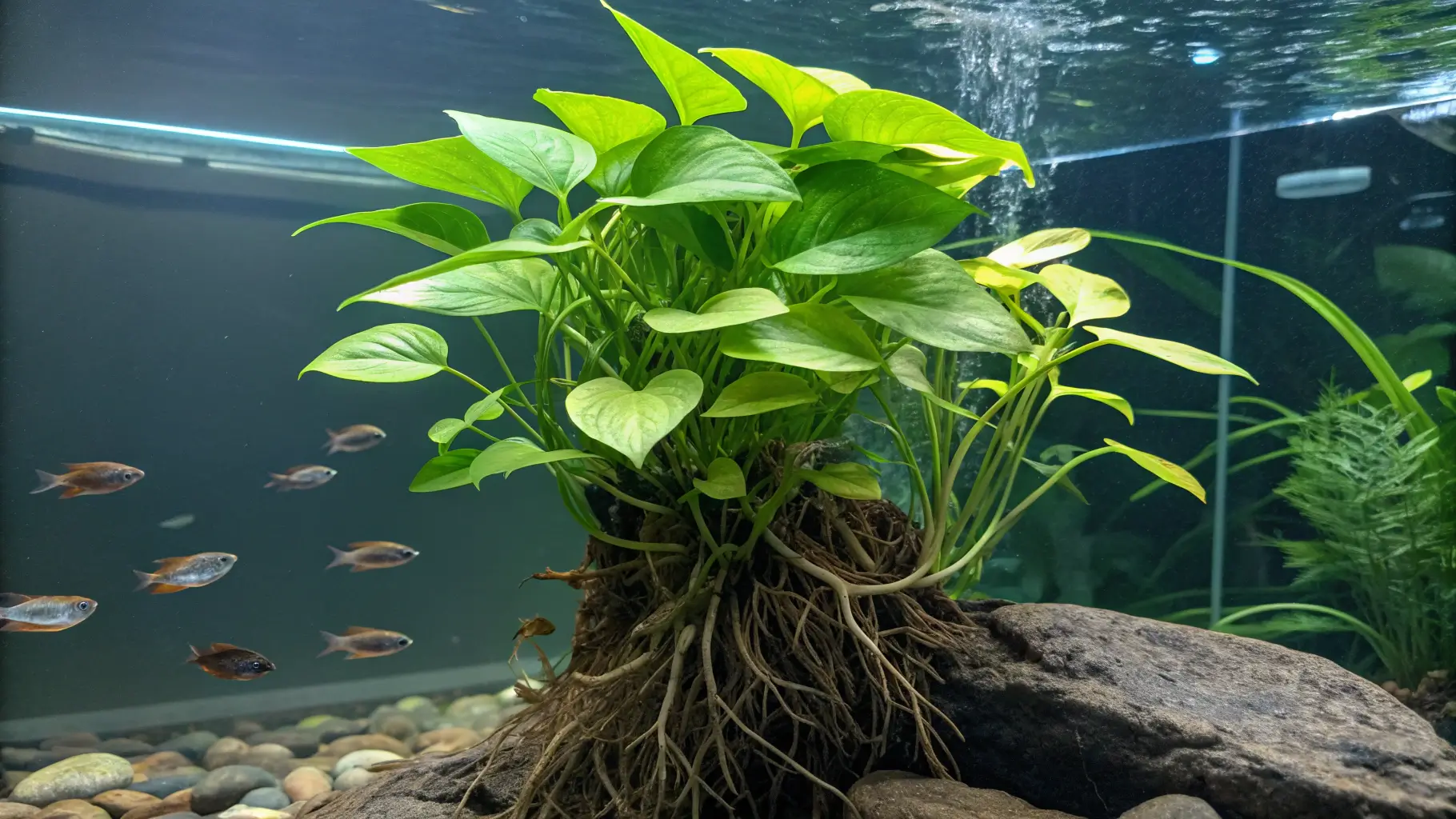Yes, absolutely! The Pothos plant (Epipremnum aureum) isn’t just a popular houseplant; it’s a powerhouse for aquariums, offering a unique blend of natural filtration, aesthetic beauty, and ecological benefits. If you’re wondering, can Pothos plant grow in aquarium, the answer is a resounding yes, and it can dramatically transform your aquatic environment. This ultimate guide will meticulously walk you through everything you need to know, from selecting the perfect variety to expert care tips, ensuring your fish thrive and your water stays sparkling clean.

TABLE OF CONTENTS
Yes, Pothos Thrives in Aquariums (Here’s Why!)
Forget complicated setups and constant chemical interventions. Pothos offers a simple yet incredibly effective way to boost your aquarium’s health. Known for its robust nature and striking foliage, Pothos, when strategically placed, acts as a natural water filter, nutrient absorber, and a stunning piece of living decor. Its ability to extract harmful compounds directly from the water makes it an invaluable addition for both seasoned aquarists and beginners. Get ready to discover how this versatile plant can contribute to a more stable, beautiful, and vibrant pothos in aquarium ecosystem.

The Amazing Benefits of Pothos for Your Aquarium Ecosystem
Integrating pothos in aquarium setups offers a myriad of advantages that go far beyond just looking good. These benefits directly contribute to a healthier, more stable environment for your aquatic inhabitants.
- Natural Water Filtration: Pothos are champion nutrient absorbers. Their roots efficiently pull out nitrates, phosphates, and even heavy metals from the water column. These compounds, often byproducts of fish waste and uneaten food, are the primary culprits behind poor water quality and algae blooms. By removing them, Pothos helps maintain pristine conditions.
- Oxygenation (Submerged Roots): While Pothos leaves are primarily air-breathing, the extensive root system, when submerged, contributes to the overall oxygen exchange in the water, albeit minimally compared to fully aquatic plants. This subtle effect still aids the ecosystem.
- Aesthetic Appeal: With its diverse leaf shapes and colors, Pothos brings a lush, natural, and vibrant “jungle” look to the top of your tank. Its trailing vines can create stunning backdrops or overhead canopies.
- Provides Hiding Spots & Enrichment: The dangling roots create naturalistic hiding spots and territories for shy fish, fry, and invertebrates like shrimp, reducing stress and promoting natural behaviors.
- Reduces Nuisance Algae: By outcompeting algae for essential nutrients like nitrates and phosphates, Pothos actively works to keep nuisance algae at bay, making your tank look cleaner and clearer.
- Helps Stabilize Water Parameters: Consistent nutrient removal leads to more stable water chemistry, reducing sudden pH swings and maintaining healthier parameters crucial for delicate aquatic life.
“Pothos plants are remarkable biofilters. Their capacity to sequester excess nitrogenous compounds and phosphorus makes them an unparalleled tool for maintaining aquatic environmental health, often outperforming many conventional filtration methods in biological efficiency,” states Dr. Anya Sharma, a marine biologist specializing in hydroponic plant systems.
Potential Risks & Important Considerations Before Adding Pothos
While the benefits are significant, it’s crucial to approach adding pothos in aquarium setups with awareness of potential risks. Our goal is to empower you with actionable information to mitigate these concerns.
- Pothos Sap Toxicity (Handle with Caution): The sap of Pothos contains calcium oxalate crystals, which can cause irritation to skin, mouth, and digestive tracts if ingested or handled without care.
- Safety Precautions: Always wear gloves when handling Pothos cuttings, especially when preparing them for your aquarium. Avoid getting the sap on your skin or in your eyes. Ensure pets and children cannot access the plant or its leaves, as ingestion can cause discomfort. While generally not lethal to fish, direct contact with sap in the water could potentially cause irritation, so ensure cuttings are thoroughly rinsed before placement.
- Aggressive Root Growth and Management Challenges: Pothos roots grow rapidly and can become extensive, potentially clogging filters or overwhelming the tank visually.
- Potential Light Competition: If the leaves grow too large or dense above the tank, they might block light from reaching fully submerged aquatic plants.
- Risk of Nutrient Depletion: In very low-nutrient tanks (e.g., heavily planted tanks with few fish), aggressive nutrient uptake by Pothos could potentially deprive other aquatic plants of essential elements long-term.
- Leaf Rot if Submerged: Pothos is not a true aquatic plant. Its leaves are designed for air, not water. If submerged, the leaves will quickly rot, polluting the water. Always ensure only the stem and roots are in the water.
Myth vs. Fact: Pothos Toxicity in Water
- Myth: Pothos is highly toxic and will poison my fish if placed in the aquarium.
- Fact: While Pothos sap is an irritant, once the plant is established with its roots in the water, the risk of poisoning fish is extremely low. The primary concern is if leaves are submerged and rot, or if fish directly ingest plant material containing the sap, which is unlikely as Pothos is typically grown emersed (roots in water, leaves out). Proper preparation (removing submerged leaves, rinsing) virtually eliminates this risk.
Choosing the Right Pothos Variety for Your Aquarium
One of the often-overlooked aspects when trying to grow Pothos in aquarium settings is the sheer diversity of Pothos varieties. While most Pothos (Epipremnum aureum) varieties will thrive, their aesthetic differences, growth habits, and leaf sizes can influence your choice.
- ‘Jade Pothos’: Known for its solid, dark green, glossy leaves. It’s a robust and classic choice, offering excellent filtration and a clean look.
- ‘Golden Pothos’: The most common variety, featuring green leaves streaked with splashes of yellow or gold. It’s highly adaptable and grows vigorously, making it a popular choice for beginners.
- ‘Neon Pothos’: Stands out with its bright, almost fluorescent lime-green leaves. It adds a vibrant pop of color but may grow slightly slower than ‘Golden’ or ‘Jade’.
- ‘Marble Queen Pothos’: Features striking green leaves heavily variegated with creamy white. This variety tends to grow a bit slower and might require slightly more light to maintain its vibrant variegation.
- ‘Silver Pothos’ (Scindapsus Pictus): While technically a different genus (Scindapsus), it’s often grouped with Pothos due to similar care requirements. Its dark green leaves have silvery-grey markings. It has a slightly slower growth rate and typically smaller leaves, making it suitable for smaller tanks where aggressive growth is a concern.
Step-by-Step Guide: How to Easily Set Up Pothos in Your Fish Tank
Getting your pothos plant grow in aquarium successfully is a straightforward process. Follow these detailed steps for a smooth setup.
Gathering Your Supplies
Before you begin, ensure you have everything you need. Starting with the right tools makes the process simple and efficient.
- Pothos Cutting: Obtain a healthy cutting from an existing Pothos plant. Look for a stem with at least 2-3 leaves and a visible “node” (a small bump where roots or new leaves emerge).
- Sharp Razor Blade or Scissors: Essential for making clean cuts that promote root growth and prevent disease.
- Aquarium-Safe Clips/Suction Cups: These are vital for securely holding your Pothos in place, preventing it from falling into the tank or floating away. Look for sturdy, non-toxic options. Brands like “Zoo Med” or “Fluval” often have suitable clips.
- Small Jar or Propagation Station (Optional): Useful for propagating new roots before placing the cutting directly in the tank.
- Grow Light (Optional but Recommended): While Pothos tolerates various light conditions, a dedicated grow light above the foliage can encourage faster, healthier growth.
Preparing Your Pothos Cuttings

Proper preparation is key to ensuring your cutting establishes roots quickly and safely.
- Identify Nodes: Along the stem, you’ll see small bumps or rings these are the nodes. This is where new roots will emerge.
- Make Clean Cuts: Using your sharp blade or scissors, make a clean cut just below a node. Each cutting should have at least one node. Aim for cuttings that are 4-8 inches long with 2-3 leaves.
- Remove Submerged Leaves: Carefully remove any leaves that would be submerged in the aquarium water. This is critical. Submerged Pothos leaves will rot, polluting your water and potentially harming your fish. Only the stem and roots should be in the water.

Strategic Placement in Your Aquarium
Where you place your pothos in aquarium can affect both its growth and the overall aesthetic.
- On-Filter Placement (Most Common): The most popular method involves tucking the Pothos stem and roots into the filter outflow or intake. The constant water flow provides nutrients and aeration, and the filter housing offers a secure spot.
- Using Suction Cup Holders: Aquarium-safe suction cups with small clips or rings can be attached to the tank rim or even inside the tank to hold cuttings. This offers flexibility in placement.
- Floating Roots in the Water: Simply allowing the roots to float freely in the water is another option, though less secure. Ensure the leaves remain completely out of the water.
- Integrating into a Hydroponic Grow Box Above the Tank: For a more advanced setup, you can create a small DIY grow box attached to the tank, allowing multiple Pothos plants to thrive with roots immersed in the tank water.
- Considerations for Water Flow: Position roots where there is good water flow to ensure optimal nutrient delivery, but avoid direct, strong currents that could dislodge the plant.
Encouraging Initial Root Development
Patience is key during the initial stages of root development for your pothos plant grow in aquarium.
- Ensure Nodes are in Water: Double-check that the nodes on your cutting are consistently submerged. This is where the magic of root growth happens.
- Monitoring Water Levels: If using a hang-on-back filter, ensure the water level is high enough for the roots to remain submerged, especially as water evaporates.
- Patience: Root development can take anywhere from a few days to a couple of weeks. Don’t be discouraged if you don’t see immediate growth.
- Avoiding Disturbances: Try to minimize moving the cuttings frequently during this initial period.
- Benefits of Initial Low Light: While Pothos loves light, overly bright light directly on the roots can sometimes encourage algae. During the first few weeks, roots develop well even in moderate light.
Essential Pothos Care & Long-Term Maintenance in Aquariums
Maintaining your pothos in aquarium is generally low-effort, but understanding its specific needs will ensure a thriving plant and a continuously healthy aquatic ecosystem.
Optimal Lighting Requirements
Pothos, while adaptable, thrives with adequate light to support robust growth, especially for its foliage above the water.
- Natural Indirect Light: Place your aquarium near a window that receives bright, indirect sunlight. Avoid direct, intense sunlight on the leaves, which can scorch them.
- Artificial Grow Lights: For tanks not near a window or for boosted growth, a simple LED grow light positioned above the Pothos foliage is highly beneficial.
- Ideal Light Intensity and Duration: Aim for 8-10 hours of light per day. Pothos doesn’t require extremely high PAR values. A standard full-spectrum LED light designed for houseplants or a lower-wattage aquarium light can work perfectly.
- Preventing Algae Growth on Roots: While some algae on roots is normal, excessive light directly on the submerged roots can promote heavy algae growth. If this becomes an issue, consider slightly shading the root zone or reducing overall light intensity.
Water Parameters & Nutrient Uptake
One of the primary reasons to grow Pothos in aquarium environments is its incredible ability to interact with water chemistry.
- Efficient Absorption of Nitrates, Phosphates, and Trace Elements: Pothos roots are highly effective at absorbing these compounds directly from the water, which are the main culprits for algae growth and poor water quality. This significantly reduces the bioload on your filter.
- Impact on Water Changes: With Pothos actively filtering your water, you might find you can slightly extend the time between water changes, though regular partial water changes are still essential for overall tank health.
- No Need for Dedicated Plant Fertilizer: Typically, the nutrients available in a stocked aquarium (from fish waste, food breakdown) are more than sufficient to nourish your Pothos. Adding dedicated liquid plant fertilizers directly to the tank water is usually unnecessary and can even harm aquatic inhabitants or encourage algae.
- Monitoring Parameters: Pothos helps stabilize pH, GH (General Hardness), and KH (Carbonate Hardness) by buffering against nutrient spikes. Continue to monitor these parameters regularly as part of your routine aquarium maintenance.
- Supplementing Nutrients for Other Plants: If you have other fully submerged aquatic plants that require specific nutrients (e.g., iron, potassium) that Pothos might be depleting, consider adding liquid fertilizers sparingly and specifically for those aquatic plants. Pothos itself rarely needs supplemental feeding in a fish tank.
Root Management & Trimming Techniques
Pothos roots can grow quite long and dense. Proper management is key to maintaining both aesthetics and tank function.
- When and How to Trim Roots: Aim to trim roots every 1-3 months, or when they become excessively long (e.g., reaching the substrate) or start to interfere with filter flow.
- Proper Cutting Techniques: Use sharp, clean scissors to snip off sections of the roots. You can remove up to 50% of the root mass without harming the plant. Trimming encourages new, healthier root growth and prevents root rot from excessively dense, stagnant root balls.
- Preventing Root Rot: Ensure roots are in a well-circulated area. Overly dense, stagnant root masses can become breeding grounds for bacteria and lead to rot. Regular trimming helps prevent this.
- Methods for Creating ‘Root Curtains’ or Barriers: Some aquarists use clear plastic barriers or cleverly position plants to create natural “curtains” with the roots, enhancing the aquascape.
Leaf Care & Dealing with Aerial Roots
Beyond the water, the visible foliage also requires some attention.
- Dusting Leaves: Pothos leaves, especially those above an open-top tank, can accumulate dust. Gently wipe them with a damp cloth to keep them clean and maximize light absorption.
- Misting Aerial Roots: As Pothos grows, it will produce “aerial roots” from its stems. These roots absorb humidity from the air. Misting them occasionally can encourage healthier foliage, especially in dry environments.
- Identifying Healthy vs. Unhealthy Leaves: Healthy leaves are vibrant green (or variegated, depending on the variety). Yellowing leaves often indicate overwatering, nutrient deficiency (in the plant, not necessarily the tank), or insufficient light. Brown, crispy edges suggest low humidity or underwatering (if outside the tank).
- What to Do with Aerial Roots: You can guide aerial roots into the water to create more submerged roots, allowing the plant to absorb even more nutrients. Alternatively, you can let them trail aesthetically, or trim them if they become unruly.
Quick Checklist for Diagnosing Yellowing Pothos Leaves:
- Light: Is it getting enough bright, indirect light? (Too little or too much can cause yellowing).
- Water Quality: Are the roots in clean aquarium water? (Poor water quality can stress the plant).
- Nutrient Deficiency (Plant): While rare in aquariums, an extremely old cutting might benefit from a very dilute, dedicated houseplant fertilizer applied only to the leaves (not the water) as a foliar spray if other issues are ruled out.
- Root Health: Are the roots healthy and free of rot? (Check by gently pulling the plant).
- Old Leaves: Is it just older leaves at the base naturally dying off? (This is normal).
Troubleshooting Common Pothos Problems in Your Aquarium
Even with the best intentions, you might encounter issues when you grow Pothos in aquarium. Here’s a practical guide to common problems, solutions, and prevention.
| Problem | Solution | Prevention |
|---|---|---|
| Yellowing Leaves | Check light (too little/much). Ensure roots are well-established. Trim off severely yellowed leaves. Review overall tank health. | Provide consistent, bright indirect light. Avoid submerging leaves. Ensure healthy root system. |
| Stunted Growth | Increase light duration/intensity (if too low). Ensure good water flow around roots for nutrient delivery. Consider larger cuttings initially. | Ensure optimal lighting. Maintain good water circulation. Start with robust cuttings. |
| Algae on Roots | Gently brush off algae during root trimming. Slightly reduce light intensity directly on roots if severe. Increase frequency of root trimming. | Avoid excessive direct light on submerged roots. Trim roots regularly to prevent dense mats where algae can accumulate. Maintain good water flow. |
| Root Rot | Trim off all rotten, mushy root sections using clean scissors. Reposition for better water flow. Ensure only stems/roots are submerged. | Never submerge leaves. Ensure good water circulation around roots. Trim dense root masses regularly. |
| Fungal Issues | Rare in water-grown Pothos. If observed on leaves, improve air circulation, reduce humidity. Remove affected leaves. | Maintain good air circulation around foliage. Avoid over-misting. |
| Pest Infestations | (Less common indoors) If present (e.g., spider mites on leaves), wipe leaves with a damp cloth or use an insecticidal soap away from the tank. | Inspect new plants/cuttings before adding them. Maintain good air circulation. |
| Insufficient Filtration | Ensure sufficient Pothos root mass for your tank size. Increase frequency of water changes. Consider adding more Pothos cuttings. | Plant adequate Pothos for tank size and bioload. Supplement with mechanical/biological filtration. Perform regular water changes. |
Pothos Compatibility: What Fish & Shrimp Thrive with Pothos?
One of the great aspects of using pothos in aquarium systems is its broad compatibility with most freshwater aquatic life. Its benefits generally enhance the environment for many species.
- Fish that Benefit from Cover and Clean Water:
- Bettas (Siamese Fighting Fish): The dangling roots create excellent resting spots and cover, reducing stress for these territorial fish.
- Guppies, Mollies, Platies: Livebearers thrive in clean, stable water, and the roots offer protection for fry.
- Tetras (Neon, Cardinal, etc.): These schooling fish appreciate the natural feel and cover provided by the roots, which mimics their natural habitat.
- Rasboras, Danios: Similar to tetras, they benefit from the improved water quality and enrichment.
- Angelfish & Gouramis: Larger, calmer fish that appreciate the stability and aesthetic appeal.
- Shrimp Compatibility: Cherry Shrimp, Amano Shrimp, Ghost Shrimp, and other dwarf shrimp species are perfectly compatible with Pothos. They will often graze on any detritus or biofilm on the roots and benefit immensely from the improved water quality.
- Fish that Might Nibble on Roots:
- Herbivores: Some highly herbivorous fish (e.g., certain larger plecos, mollies if food is scarce) might occasionally nibble on the fine roots, but generally, Pothos roots are not their preferred food source.
- Larger Cichlids: Some larger, more aggressive cichlid species might uproot or disturb the Pothos simply due to their digging habits, not necessarily to eat it.
- Mitigation Strategies: Ensure fish are well-fed. For larger cichlids, use very secure mounting methods (e.g., firmly tucked into filter, or in a dedicated grow box).
Pothos significantly contributes to environmental enrichment by creating a more naturalistic and visually stimulating habitat. This leads to reduced stress, improved coloration, and more natural behaviors in your fish.
Pothos vs. Other Aquatic Filtration Plants: A Quick Comparison
When considering natural filtration for your aquarium, Pothos isn’t the only option, but it often stands out. Here’s how pothos in aquarium use compares to other popular houseplant alternatives.
| Feature | Pothos (Epipremnum aureum) | Peace Lily (Spathiphyllum) | Lucky Bamboo (Dracaena sanderiana) | Syngonium (Arrowhead Plant) |
|---|---|---|---|---|
| Ease of Care | Very Easy. Highly adaptable, forgiving. | Easy. Prefers consistent moisture. | Very Easy. Almost indestructible, requires minimal care. | Easy. Similar to Pothos, slightly less robust. |
| Filtration Capacity | Excellent. Aggressive nitrate/phosphate absorption. | Good. Effective nutrient absorber. | Moderate. Absorbs some nutrients. | Good. Effective nitrate/phosphate absorption. |
| Growth Habits | Trailing vines, extensive aerial & water roots. Rapid growth. | Upright, glossy leaves, prominent white flowers. Moderate growth. | Stiff, cane-like stems with sparse leaves. Slow to moderate growth. | Trailing/climbing vines, arrowhead-shaped leaves. Moderate growth. |
| Toxicity Notes | Sap contains calcium oxalates (irritant). Leaves must not be submerged. | Contains calcium oxalates (irritant). Leaves must not be submerged. | Mildly toxic if ingested (saponins). Relatively safe for aquatic use. | Contains calcium oxalates (irritant). Leaves must not be submerged. |
| Common Use in Aquariums | Roots in water, foliage out. Hung on filters, tank rim. | Roots in water, foliage out. Often in filter or suction cups. | Stems in water, foliage out. Popular for minimalist setups. | Roots in water, foliage out. Similar to Pothos. |
| Why Choose Pothos? | Unmatched filtration power, rapid growth, diverse varieties, highly forgiving. Great for both aesthetics and water quality. | Excellent filtration, elegant look, can flower. Slightly less vigorous roots. | Simple, architectural look, incredibly low maintenance. Lower filtration. | Similar benefits to Pothos but often with slightly less aggressive growth. |
Expert Tips for a Thriving Pothos Aquarium
To truly maximize the benefits of pothos plant grow in aquarium, consider these expert insights from seasoned aquarists and plant enthusiasts.
- Acclimation Best Practices for New Cuttings: For optimal success, consider rooting new Pothos cuttings in a separate jar of dechlorinated water (or even tank water) for a week or two before introducing them to the main aquarium. This allows roots to establish without the stress of an active tank environment.
- Creative Aquascaping and Display Ideas: Don’t just tuck your Pothos away!
- Root Curtains: Train roots to cascade down the back of the tank, creating a living backdrop.
- Overhead Canopy: Allow vines to grow across the tank lid (if open-top), creating shaded areas and a lush, jungle-like effect.
- Nano Tank Solutions: For smaller tanks, opt for smaller cuttings or varieties like ‘Silver Pothos’ (Scindapsus Pictus) to avoid overwhelming the space. Utilize small suction-cup holders.
- Integrating Pothos with Other Filtration Methods: Pothos is a fantastic aquarium water filtration plant, but it works best as a supplement to your existing mechanical and biological filtration. It’s not a complete replacement. Use it to enhance water quality, not as a sole filter.
- Advanced Water Parameter Monitoring: While Pothos helps stabilize parameters, for optimal plant and fish health, occasionally test for nitrates, phosphates, and even trace elements. This helps you understand the overall nutrient balance and whether any minor adjustments (e.g., for other plants) are needed.
- Propagation for Continuous Benefits: As your Pothos grows, take new cuttings from healthy vines. This allows you to continuously propagate more plants, creating a sustainable source of natural filtration and expanding your green oasis.
Frequently Asked Questions (FAQ)
Here are some of the most common questions about pothos in aquarium setups, answered concisely.
Is Pothos really toxic to fish or shrimp? No, not directly in a properly set up aquarium. While Pothos sap contains calcium oxalate crystals which are irritating, as long as only the roots are submerged and leaves are kept out of the water, the risk to fish or shrimp is negligible. The compounds are not released into the water in toxic amounts. Read more in our “Potential Risks” section.
Can Pothos grow fully submerged? No, Pothos is not a true aquatic plant and its leaves will rot if submerged, polluting your aquarium water. Only the stem and roots should be in the water, with the foliage above the waterline.
Do Pothos roots need light in an aquarium? No, Pothos roots do not specifically need light to grow. They will thrive in dim or dark conditions within the water, absorbing nutrients. In fact, too much direct light on submerged roots can sometimes encourage algae growth.
How fast does Pothos grow in a fish tank? Pothos can grow quite rapidly in an aquarium, especially ‘Golden’ and ‘Jade’ varieties, given adequate light and nutrients. You can expect significant root and foliage growth within a few weeks to months. Regular trimming may be needed.
Can Pothos roots clog my filter? Yes, if left unchecked, the extensive root system of pothos plant grow in aquarium setups can eventually grow into and potentially clog filter intakes or block media. Regular root trimming is essential to prevent this.
How do Pothos clean aquarium water? Pothos cleans aquarium water primarily by absorbing excess nitrates, phosphates, and other dissolved organic compounds directly through its root system. These nutrients, which come from fish waste and decaying matter, are used by the plant for its own growth, effectively removing them from the water column.
Conclusion: Enhance Your Aquarium with Pothos for a Happier Ecosystem
Bringing pothos in aquarium environments is one of the smartest and most aesthetically pleasing choices you can make for your aquatic hobby. From its unparalleled ability to naturally filter harmful nitrates and phosphates to its beautiful contribution to your aquascape, Pothos offers a host of benefits that lead to cleaner water, healthier fish, and a more stable, vibrant ecosystem.
Embrace this easy-to-care-for plant and witness the transformation of your tank. With the right variety, proper setup, and consistent, simple care, your pothos in aquarium will thrive, rewarding you with lush greenery and a naturally balanced aquatic paradise. Take the plunge and give your fish the gift of cleaner, clearer water today! Share your Pothos journey or questions in the comments below we’d love to hear from you!
